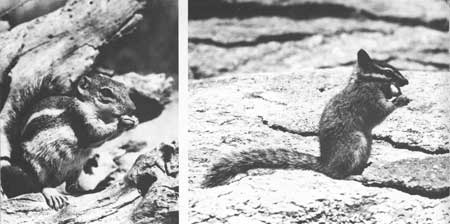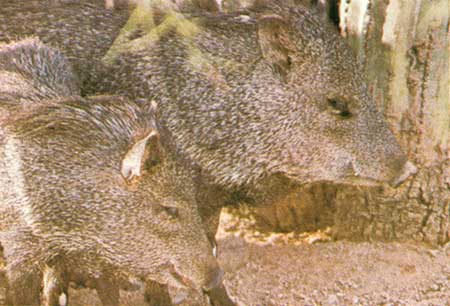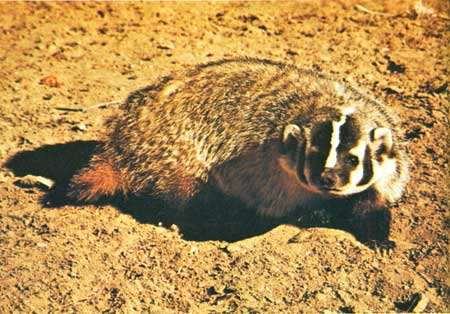|
SAGUARO National Park |
 |
animals and how they survive (continued)
Mammals
The most frequently seen mammals in the monument are rodents and members of the hare clan. Among the latter group are two rabbits. The DESERT COTTONTAIL is common in the lower levels of the desert, and the EASTERN COTTONTAIL inhabits the mountains to 8,600 feet. Adaptable to a wide range of environmental conditions, these animals augment the water they obtain from springs with moisture derived from sap. There are two species of JACKRABBITS (actually hares) in the monument. They remain at the lower levels, where they are a common sight amid the cactuses. Unlike rabbits, which are born naked, blind, and helpless, hares are born with fur, open eyes, and the ability to move about.
Among the monument rodents the largest are the PORCUPINES. Though rarely seen, they leave characteristic scars on pinyons and ponderosa pines, recording their feeding habits at higher elevations. They are also active in the chaparral belt, and an individual occasionally wanders down into the desert where it eats mesquite beans and samples the bark of ocotillos and other shrubs and trees.
Several species of ground squirrels are abundant. At the lower levels, especially among creosotebushes, the ROUNDTAIL GROUND SQUIRREL finds suitable living conditions, while the YUMA ANTELOPE GROUND SQUIRREL ranges from the cactus forests into grassland. At this elevation and upward through the pinyons and junipers, the ROCK SQUIRREL makes its burrows in rocky ledges and brushy canyons. CLIFF CHIPMUNKS enliven the oak-pine woodland and higher forests with their quick movements and cheerful chatter.
 The Yuma (or gray-tailed) antelope ground squirrel, a chipmunk-like rodent of the desert and grassland (left). In the monument, the cliff chipmunk prefers the oak-pine woodland and the coniferous forest (right). |
KANGAROO RATS honeycomb the soil from the cactus forests up to the oak-pine belt. Remaining underground during the day, they are frequently seen at night. These animals do not require free water; they obtain adequate moisture from a chemical process within the body during the digestion of food, which is mostly dry seeds. WOODRATS, famous in song and story as pack rats or trade rats because of their habit of carrying away objects of human use and leaving something else in their place, are found throughout the monument at all elevations. Look for their stick nests among the pads of prickly pear, a favorite food.
 The four species of kangaroo rats found in Saguaro look too much alike to be distinguished in the field. (Photo by Harold T. Coss, Jr.) |
Other rodents common in the monument include the CACTUS MOUSE, GRASSHOPPER MOUSE, DEER MOUSE, and VALLEY POCKET GOPHER.
Among the larger mammals in the monument are two species of deer. The MULE DEER subsists in winter on cactus fruits, ephemerals, and other desert vegetation. In summer they find abundant browse in the higher oak woodland. The forested areas along the crest of the Rincons support a population of the smaller WHITETAIL DEER. These graceful animals browse on aspen, buckbrush, and other shrubs and small trees. They are particularly fond of acorns. When snow flies some descend to the protective cover of the oak-pine woodlands and chaparral.
 Mule deer. (Photo by Harold T. Coss, Jr.) |
PECCARIES, characteristic of southwestern deserts, usually travel in herds of from three to as many as 50 animals. They wander through the groves of mesquite along desert washes, and root among beds of pricklypear. Pricklypear pads are their chief food; they are said to feed upon cactus fruits in summer and autumn. In addition to the moisture obtained from succulent stems and fruits, peccaries require considerable water, hence they frequent springs and seeps. Small bands of these animals occasionally visit the waterhole near the visitor center, where they are excitedly watched by visitors fortunate enough to be in the lobby at the time.
 Collared peccary, or javelina. (Photo by Harold T. Coss, Jr.) |
Saguaro National Monument also has a large number of predatory animals. Many of these, popularly believed to be exclusively meat-eaters, actually also eat much vegetable matter. The predators—an exciting part of the monument's fauna—play an important role in preventing overpopulation of the prolific rodents.
Chief among predators is the COYOTE, which ranges throughout the monument. In winter, coyotes are found principally below 6,000 feet, where hunting is easier and where rodents remain longer out of hibernation. They are also known to roam the forested heights of the Rincons and Tanque Verde Ridge. Studies of coyotes in the monument made by biologist Lowell Sumner in January 1951 showed that their winter diet consisted of about 78 percent fruits and seeds, 11 percent small rodents, 7 percent deer, 4 percent birds, reptiles, insects, and carrion, and 1 percent debris. The coyote is one of the principal wild creatures associated with the history of the West, and its continuing presence in the monument brings a thrill of pleasure to visitors who hear the voices of the pack during the calm of evening, or catch a glimpse of one of these gray canines trotting through open stands of saguaros. BOBCATS, ranging over much the same territory as coyotes, subsist principally on rodents, birds, and insects. Because of their secretive habits, they are seldom seen.
The GRAY FOX is another fairly common inhabitant of the cactus desert and higher brushlands, and is also known to roam the forested uplands. It is usually seen at night. Rodents are its principal source of food, but it also preys on birds and reptiles and eats much vegetable matter. The smaller and rather rare KIT FOX, restricted mostly to the desert, is also a night hunter. Kangaroo rats are a favorite item in the kit fox diet, but these small predators also eat grasshoppers and other insects.
Skunks, members of the weasel family, are relatively common in the monument, and several species inhabit areas where water is available. They are usually active at night. The HOGNOSE SKUNK is a desert dweller recognizable by its solid-white back. It roots for insect larvae and eats cactus fruits, bird eggs, and nestlings. The STRIPED SKUNK ranges throughout the monument; the SPOTTED SKUNK is found at all elevations, usually among rocks. Insects, rodents, and fruits are its main food.
Another member of the weasel family, the BADGER, is occasionally seen in the desert although it is by no means limited to that habitat. The badger feeds mainly on rodents, which it digs from burrows with its strong forelegs and heavy claws.
 Badger. |
The RACCOON, longer-legged than the badger, is readily recognized by its gray fur, black mask, and ambling gait. It inhabits brushy canyons having permanent water, and sometimes wanders up into the pine belt in summer. Amphibians, scarce as they are, and other water creatures are among the preferred foods of raccoons; but they also eat small rodents and plant food, including berries, acorns, and other fruits.
The RINGTAIL, a smaller relative of the raccoon, is somewhat similar in habitat preference and nocturnal habits. Its flattened, bushy tail, acting as a balancer, helps this short-legged, agile animal in leaping from point to point on the steep rocky surfaces it seems to favor. It sometimes takes up residence in little-used or abandoned buildings, where small rodents, its principal source of food, are usually abundant. About the size of a house cat, it has large eyes and ears and alternating dark and light bands on its tail.
A tropical animal that seems to be extending its range northward, the COATI (or coatimundi) is often seen in the forests of the Rincons. With long snout and long, banded tail, it looks something like an elongated raccoon, to which it too is related. These omnivorous animals travel in bands, rooting among leaves for insects and whatever else they can find.
 Coati, or coatimundi. (Photo by Fred D. Mang, Jr.) |

|

|
|
|
|
Last Modified: Sat, Nov 4 2006 10:00:00 pm PST |


